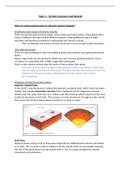Topic 1 - Tectonic processes and hazards
Why are some locations more at risk from tectonic hazards?
Distribution and causes of tectonic hazards:
There are several major tectonic plates, minor plates and micro-plates. These plates often
move in different directions and at different speeds, creating different types of plate
boundary and therefore variations in earthquake and volcanic activity.
- Most earthquake and volcanic activity are found in zones along the plate boundary.
Intra-plate processes:
There are also earthquakes near the middle of plates (intra-plates) associated with ancient
faults.
Newer large faults can also be found, which may turn into new plate boundaries. These
situations are associated with smaller magnitude earthquake.
There is also volcanic activity near the centre of some plates (hot spots)
Hot spots → A hot spot is a region deep within the Earth's mantle from which heat
rises through the process of convection. This heat facilitates the melting of rock. The
melted rock, known as magma, often pushes through cracks in the crust to
form volcanoes
Processes moving the tectonic plates:
MANTLE CONVECTION:
In the Earth’s core the decay of radioactive elements produces heat, which heats the lower
mantle. This creates convection currents in the mantle where hot magma has a lower
density and rises away from the core. It then cools due to being further away from the core,
its density increases, and it sinks. This creates a circular movement of magma in the mantle.
This causes the tectonic plates above convection currents to move.
SLAB PULL:
Newly formed oceanic crust at mid-ocean ridges like the MAR becomes denser and thicker
as it cools. This crust then sinks or subduct into the mantle under its own weight and pulls
the rest of the plate down into the mantle with it. This is a major driving force of plate
movement and subduction
,SUBDUCTION:
Is the destruction of crust. When two oceanic plates. An oceanic and continental plate move
towards each other, the denser oceanic plate will be forced to slide under the continental
the other oceanic plate and sink/subduct into the mantle. This occurs in the subduction
zone / Benioff zone
SEA-FLOOR SPREADING:
Is the creation of new crust. When hot magma is forced up from the asthenosphere it cools
and hardens to form new oceanic crust – forming mid-ocean ridges or underwater mountain
ranges. This new crust pushes tectonic plates apart through seafloor spreading
Thus, although crust is being formed through seafloor spreading, it’s also being destroyed
through subduction driven by slab-pull
Structure of the Earth with mantle plumes and hotspots:
, Plate boundaries:
For major plate boundaries are created by the direction of trade movement – destructive
(fold mountains or island arcs), constructive (mid-ocean ridges), collision (fold mountains
and plateaus) and transform (conservative or major faults).
Destructive - This occurs when oceanic and continental plates move together.
The oceanic plate is forced under the lighter continental plate. Friction causes melting of
the oceanic plate and may trigger earthquakes. Magma rises up through cracks and erupts
onto the surface.
Constructive - A constructive plate boundary, sometimes called a divergent plate margin,
occurs when plates move apart. Volcanoes are formed as magma wells up to fill the gap,
and eventually new crust is formed.






